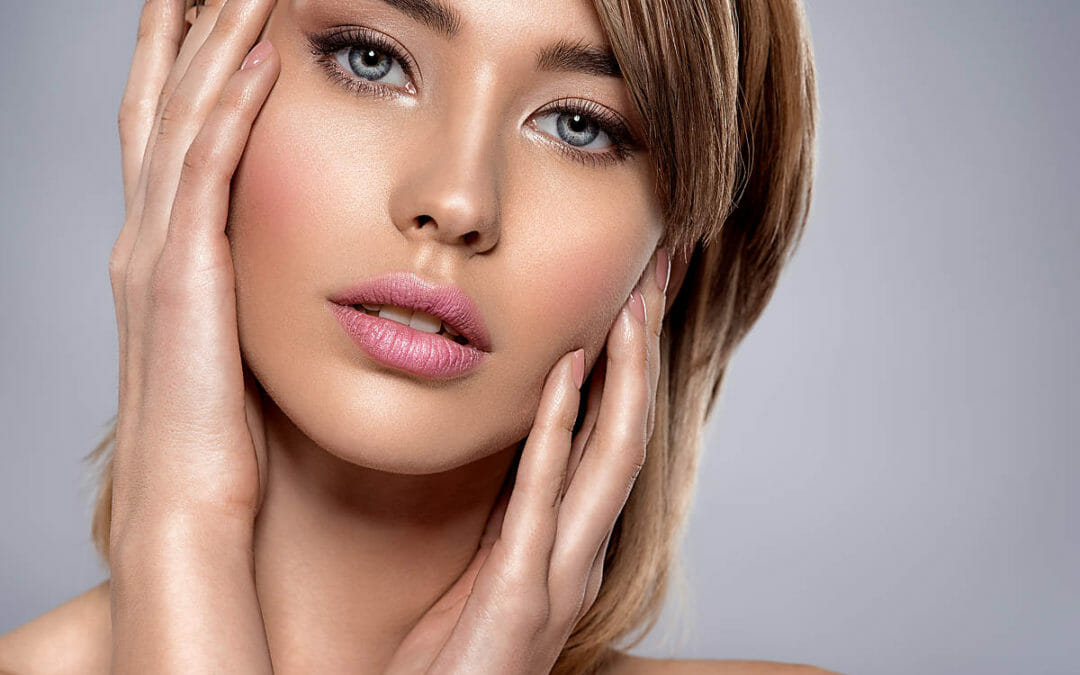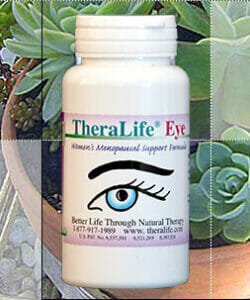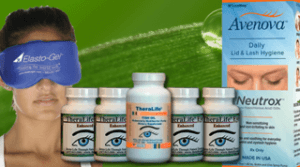Effective Treatment for Menopause And Dry Eyes
To treat MN- there are options for synthetic hormones – which is very effective in relieving symptoms of menopause. However, it carries the risk of ovarian cancer for those prone. There is a natural alternative for MN relief based on soy extracts called Isoflavones.
Menopausal Support
An effective oral dry eye treatment that works.
What is Menopause?
Menopause (MN) is when the body experiences several physiological changes due to fluctuating hormones.
These fluctuations can cause various physical and emotional symptoms, including dry eyes.
Dry eyes may be annoying for those going through menopause, but they can also signal more serious underlying health concerns.
It is, therefore, essential to understand the connection between menopause and dry eyes and how to manage these symptoms effectively.
This article explores the link between menopause and dry eyes, discusses possible causes, and provides advice on ways to find relief from this uncomfortable condition.
The Link Between Menopause And Dry Eyes
Up to 70% of women experience dry eyes during MN. This condition, known as Keratoconjunctivitis sicca (KCS), can cause uncomfortable symptoms such as watery eyes.
The hormonal changes associated with menopause reduce the quality of tear production in some individuals, leading to dryness in the eye area. As a result, the body produces more tears than usual to compensate for this lack of moisture.
Unfortunately, these additional tears may not contain enough lipids or proteins to adequately lubricate the eyes, causing them to become overly watery – a symptom commonly called ‘watery eyes.’
To treat KCS-related dry eyes effectively, doctors usually recommend using artificial tears or eye drops containing preservatives that help keep the eyes hydrated and protect against further irritation.
Additionally, increasing dietary intake of omega-3 fatty acids has improved tear function by keeping cell membranes healthy and maintaining proper oil production levels around the eye area.
By managing environmental factors like air pollution and lifestyle habits such as smoking and drinking alcohol excessively, sufferers can also reduce their risk of developing dryness-related issues, including watery eyes.
Symptoms Of Menopause And Dry Eyes
Menopause may cause various physical and emotional changes, including watery eyes. While many women are familiar with the general symptoms associated with MN, such as hot flashes, night sweats, and fatigue, far fewer recognize that it can also increase tear production.
Research indicates that hormonal shifts during the MN transition may cause disruptions to the lacrimal glands responsible for producing tears which could lead to watery eyes.
It is essential to distinguish between menopausal-related watery eyes and dry eye syndrome (DES). DES is from environmental factors like air pollution or extended screen time on digital devices and has similar symptoms but different underlying causes than those related to MN.
Symptoms of DES include stinging, burning sensation in the eyes, and redness, while menopausal-related watery eyes are usually present with increased tearing without discomfort or inflammation.
Treatment options for both conditions depend upon their severity; however, artificial tears relieve both watery eyes due to their ability to lubricate the eye’s surface and replace lost moisture.
Additionally, lifestyle modifications such as avoiding smoke, using protective eyewear outdoors, or looking at screens may reduce irritation associated with DES.
As such, determining if menopause or another factor caused dry eyes will help guide treatment decisions. Moving forward, we will explore possible causes of menopause-related watery eyes.
Causes Of Menopause And Dry Eyes
The connection between menopause and watery eyes can be as mysterious as the ocean’s depths, but understanding it is essential for finding relief. This section will explore some of the causes behind this condition to better equip readers with knowledge that could lead to effective treatments.
A hormonal imbalance during menopause often leads to decreased production of certain hormones needed to keep tear glands functioning normally. As a result, these glands may become irritated or inflamed due to increased dryness or disruptions in their natural lubrication process. Consequently, tears produced by the eye can be excessively thin or thick – leading to uncomfortable symptoms such as redness, burning sensations, itching, and even excessive tearing.
In addition to hormone-related issues, environmental factors like air pollution can also irritate the eyes and cause them to produce more tears than usual. Pollutants such as dust mites, pollen particles, and other airborne allergens can trigger an immune system response, resulting in inflammation and overproduction of fluids from the tear glands.
Given its potential complexity, diagnosing menopause-related watery eyes requires careful observation and evaluation by medical professionals to design appropriate treatment plans.
Diagnosing Menopause And Dry Eyes
A combination of symptoms comprises the diagnosis of menopause-related dry eyes. Patients may experience dryness, irritation, redness, and increased sensitivity to light in the affected eye or eyes. Additionally, hormonal changes associated with menopause can cause an increase in tear production that results in watery eyes.
If these symptoms are present for several weeks or months without relief from over-the-counter treatments, seeking medical advice as soon as possible is essential. A doctor will begin by taking a detailed history and conducting a physical examination, including checking the patient’s vision.
Other tests may include measuring tear production and assessing ocular surface health to rule out other causes of dry eyes, such as allergies or infection. In some cases, blood tests may be necessary to evaluate hormone levels related to menopausal status if there is suspicion of underlying medical issues leading to the condition.
Upon completing all diagnostic testing, patients should receive appropriate treatment options tailored to their cases – this could range from lifestyle modifications and medications to surgical procedures depending upon severity and symptomology.
With proper management, many individuals find significant relief from their menopause-related watery eyes so they can continue.
A variety of methods can treat Menopause-related dry eyes.
Natural remedies, such as cold compresses and artificial tears, are often recommended to relieve menopausal dry eye symptoms.
These natural treatments are generally considered safe. However, it is essential to consult a healthcare professional before beginning any treatment plan.
In addition to natural remedies, prescription drugs can manage menopause-related dry eyes.
Commonly prescribed medications include antihistamines and decongestants, which can help reduce inflammation in the tear ducts.
Use these medications carefully, as they can have adverse side effects without medical supervision.
Many women find effective relief from their menopause-related watery eyes with proper diagnosis and treatment.
Tailored treatment plans to each individual’s needs and preferences.
For some women, this may mean relying solely on natural treatments, while others might prefer more comprehensive approaches that combine lifestyle changes and medication management.
Whatever approach you choose, working closely with your healthcare provider throughout the process is essential to ensure optimal results.
Lifestyle changes can manage menopause-related watery eyes over time.
Lifestyle Changes To Manage Menopause And Dry Eyes
The onset of MN can cause various issues, including dry eyes. Lifestyle changes are often necessary to manage the effects of menopause-related watery eyes.
A balanced diet is essential for individuals experiencing watery eyes associated with MN. Dietary modifications and physical activity play key roles in managing this condition. Eating plenty of fruits and vegetables helps ensure that your body gets all the vitamins and minerals, while avoiding processed foods will reduce inflammation, which can contribute to eye irritation. Additionally, increasing the intake of omega-3 fatty acids through sources such as salmon or flaxseed oil has been found to relieve dry eye syndrome related to menopause.
Regular exercise is also essential to reduce symptoms associated with menopause-related watery eyes. Research suggests aerobic exercise can improve tear production by stimulating nerves that regulate tear gland secretion, improving ocular comfort overall. Additionally, regular movement increases blood flow throughout the body, providing oxygen and nutrients needed to properly function in various organs and systems, including those involved with vision health.
Taking these proactive steps can help alleviate some of the discomfort experienced with MN dry eyes, allowing you to go about your daily activities more efficiently. With appropriate lifestyle adjustments, many individuals have reduced their symptoms significantly without resorting solely to home remedies or medications for relief.
Home Remedies For Menopause and Dry Eyes
The adage “an ounce of prevention is worth a pound of cure” applies to many ailments, and menopause-related watery eyes are no exception.
Home remedies can help lessen the frequency and severity of watery eyes due to MN hormone fluctuations. Such treatments include eye massage, nutrition advice, and lifestyle changes.
Eye massage has been found helpful in reducing symptoms of dryness, burning, or itching in the eyes. It involves gently pressing on specific points around the eye area – including temples, eyebrows, cheeks, and nose bridge – for about 10 seconds at each end. The goal is to reduce tension caused by stress that may contribute to dry eyes during menopause.
In addition to massage, dietary changes such as eating foods rich in Omega-3 fatty acids like salmon and tuna can relieve dry eyes associated with menopause.
Hydrating often throughout the day will keep your body healthy and strong enough to fend off any issues related to hormone imbalance or other conditions linked to MN, such as thyroid disease or anemia.
Taking these steps now can help prevent more severe problems down the line when it comes to managing your health during this critical stage of life. With proper care and attention, you should be able to effectively manage your symptoms without medical intervention — at least initially.
When To See A Doctor For Menopause And Dry Eyes
Sometimes, home remedies for menopause-related watery eyes are not enough to relieve the symptom. When this is the case, medical care is crucial.
Hormone or hormone replacement therapy (HRT) can treat dry eyes associated with menopause. HRT works by restoring hormonal balance to alleviate symptoms such as hot flashes, night sweats, and vaginal dryness often accompanying menopause. It can also help reduce the severity of dry eyes caused by lowered estrogen levels during menopause. However, there can be risks involved with taking hormones, so it’s important to discuss all options with your doctor before deciding on treatment.
Other treatments for watery eyes related to menopause include:
– Using artificial tears regularly
– Trying cool compresses or using cold packs around the eye area
– Taking steps to reduce stress levels
It is best to seek medical advice from an experienced healthcare professional if home remedies do not relieve menopause-related watery eyes after several weeks.
A doctor will consider each individual’s health and history before recommending any specific action.
Frequently Asked Questions
Are There Any Long-Term Effects Of Menopause And Dry Eyes?
The question of the long-term effects of menopause-related dry eyes is essential.
Research has shown that hormonal imbalances, particularly estrogen and progesterone, can directly affect blood pressure regulation, which may cause or worsen the condition.
The good news is that while controlling these hormonal changes can be difficult, symptoms such as watery eyes are often reversible with proper treatment.
With careful monitoring by your physician and lifestyle adjustments like reducing stress levels, you can find relief from this troublesome symptom.
Is It Possible To Prevent Menopause-Related Dry Eyes?
It is possible to prevent menopause-related dry eyes in some cases.
Dry eyes, a common symptom of menopause due to changing hormone levels, can be caused by environmental factors and medications.
It is essential to practice good eye hygiene habits, such as avoiding direct exposure to wind or smoke, using artificial tears regularly, and wearing protective eyewear outdoors To reduce the risk of developing dry eyes during menopause.
Additionally, women experiencing hormonal imbalance may benefit from supplements containing omega-3 fatty acids and antioxidants, which can help restore balance within the body.
Finally, consulting an ophthalmologist for further evaluation and treatment may prove beneficial in preventing symptoms associated with menopause-related watery eyes.
What Happens If Menopause-Related Dry Eyes Are Left Untreated?
Studies have found that approximately 80% of perimenopausal women suffer from dry eyes.
If left untreated, menopause-related dry eyes can lead to various complications, including infection and impairment of vision.
Symptom triggers such as bright lights, wind, smoke, or allergies are often the result of a hormone imbalance caused by fluctuations in progesterone and estrogen levels during menopause.
It is essential to seek treatment options that provide relief and increase comfort while reducing inflammation to prevent these symptoms.
Are There Any Supplements Or Vitamins That Can Help With Menopause-Related Dry Eyes?
Natural remedies and hormone therapy are effective in addressing menopause-related watery eyes.
Supplements such as omega-3 fatty acids, black cohosh, ginseng, and evening primrose oil have anti-inflammatory properties, which can help reduce the symptoms of dry eyes associated with menopause.
Hormone replacement therapy (HRT) is another option for those looking for relief from watery eyes due to hormonal changes occurring during menopause.
While HRT may provide significant symptom relief, it should not be taken without medical advice since there are potential risks associated with its use.
How Quickly Can The Symptoms Of Menopause-Related Dry Eyes Improve With Treatment?
Recent studies suggest that nearly 40% of women over 45 experience watery eyes as a symptom of menopause.
Treatment for these symptoms can address dietary triggers and hormonal imbalances, with many patients experiencing improvement in their symptoms within weeks or even days when following recommended treatment plans.
Identifying possible underlying causes, such as certain foods or lifestyle choices that may trigger an increase in watery eye symptoms to achieve maximum benefit from treatment, is essential.
Once identified, avoiding those triggers and rebalancing hormones through diet and supplements can lead to significant relief from menopause-related watery eyes in the short term.
Conclusion
The effects of menopause-related dry eyes can be long-lasting and disruptive to daily life. It is vital for individuals experiencing this symptom to recognize the importance of seeking treatment as soon as possible to reduce their discomfort.
Treatment options vary depending on the severity of symptoms but may include supplements or vitamins, lifestyle changes, or medications.
For example, a hypothetical patient might begin with lifestyle modifications such as avoiding irritants that trigger symptoms and using artificial tears regularly throughout the day to help keep eyes moist and comfortable. In addition, they could try taking omega-3 fatty acids supplements can reduce inflammation in the eye area and improve overall ocular health.
With proper management, patients should notice an improvement within two weeks after beginning treatment, although results may vary from person to person.
References
The definition and classification of dry eye disease: Report of the Definition and Classification Subcommittee of the International Dry Eye WorkShop (2007) Ocul Surf. 2007;5:75–92. – PubMed
Lin PY, Tsai SY, Cheng CY, Liu JH, Chou P, Hsu WM. Prevalence of dry eye among an elderly Chinese population in Taiwan: The Shihpai Eye Study. Ophthalmology. 2003;110:1096–101. – PubMed
McCarty CA, Bansal AK, Livingston PM, Stanislavsky YL, Taylor HR. The epidemiology of dry eye in Melbourne, Australia. Ophthalmology. 1998;105:1114–9. – PubMed
Schaumberg DA, Sullivan DA, Buring JE, Dana MR. Prevalence of dry eye syndrome among US women. Am J Ophthalmol. 2003;136:318–26. – PubMed
Ablamowicz AF, Nichols JJ, Nichols KK. Association between serum levels of testosterone and estradiol with meibomian gland assessments in postmenopausal women. Invest Ophthalmol Vis Sci. 2016;57:295–300. – PMC – PubM






